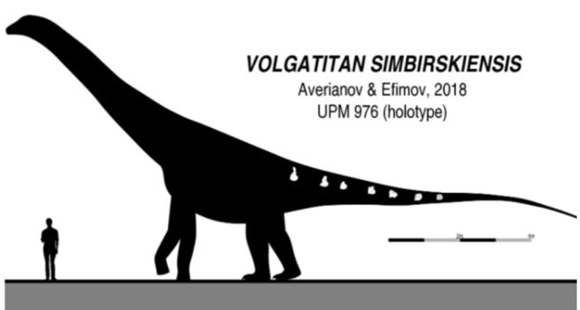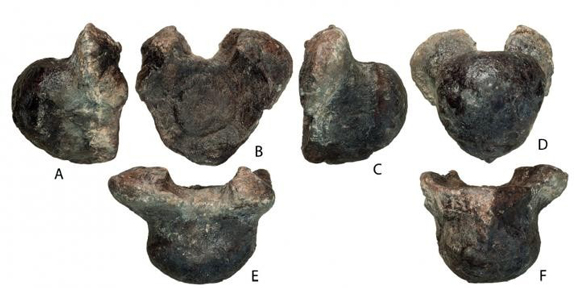Russian Scientists Announce New Dinosaur Discovery
Volgatitan simbirskiensis – Early Cretaceous Leviathan
A team of palaeontologists from Russia have announced the discovery a new genus of titanosaur from fossil bones found on the western bank of the River Volga close to the village of Slantsevy Rudnik in Ulyanovsk Oblast (western Russia). The dinosaur has been named Volgatitan simbirskiensis, it is one of a trio of sauropods recently described from Russian deposits, the others being Tengrisaurus starkovi and Sibirotitan astrosacralis, both of these herbivorous, long-necked dinosaurs were named and described in 2017.
Volgatitan simbirskiensis
V. simbirskiensis has been named based on the study of seven tail bones (caudal vertebrae), the first of which were discovered following a rock fall on the Volga River back in 1982.
A Scale Drawing of Volgatitan simbirskiensis Showing the Anatomical Position of the Known Fossil Material
Picture credit: St Petersburg State University
For models and replicas of titanosaurs and other sauropods: Dinosaur and Prehistoric Animal Models.
Tell Tale Tail Bones
Fortunately, for the Sauropoda, vertebrae can be quite diagnostic when it comes to ascribing new genera. Titanosaurs for example, have distinctive shaped caudal vertebrae, especially towards the base of the tail (proximal end close to the hips). The proximal tail bones of titanosaurs are procoelous (pronounced pro-see-lus), that is, the front face of the bone is concave and the opposite face, the bit that points in the direction of the tail, is bulbous (convex).
Views of the Holotype Caudal Vertebra of V. simbirskiensis
Picture credit: Alexander Averianov and Vladimir Efimov
The photograph (above) shows the holotype caudal vertebra of Volgatitan simbirskiensis in right lateral (A), anterior (B), left lateral (C), posterior (D), dorsal (E) and ventral (F) views.
Dinosaur Nomenclature
The dinosaur’s genus honours the Volga River, whilst the trivial name is in honour of the old name for the city of Ulyanovsk (Simbirsk), after all, the fossils were found just three miles to the north of the city. Aleksandr Averianov, one of the authors of a scientific paper describing this new titanosaur, published in the journal “Biological Communications”, explained that the description of dinosaur taxa in recent years has become possible due to the progress in understanding the anatomy and phylogeny of the Dinosauria. Furthermore, the recent Russian sauropod discoveries have allowed scientists to learn more about how these species of lizard-hipped reptiles had lived and developed.
Based on comparisons with the fossilised bones of more complete titanosaurs, Volgatitan is estimated to have been around 16 metres long. Fully fused neural arches on the centrum from the most proximal of the caudal vertebrae indicate that the bones came from a fully, mature adult animal.
It had been thought that titanosaurs evolved in the Southern Hemisphere, specifically South America, with some taxa migrating into North America, Asia and Europe later in the Cretaceous. However, the formal description of Volgatitan coming so soon after the naming of Tengrisaurus from the Early Cretaceous of Transbaikal Region, suggests that Early Cretaceous titanosaurs were more widely distributed. It is possible to postulate that important stages in the evolution of this group of long-necked dinosaurs may have taken place in eastern Europe and Asia.
For an article published in 2017 about the discovery of a new species of African titanosaur: Shingopana songwensis from south-western Tanzania.
To read about an Australian titanosaur discovery made in 2017: Titanosaur “Judy” from the Outback.



